Physical Address
304 North Cardinal St.
Dorchester Center, MA 02124
In most respects, the microscopic features of the mandible and maxilla differ in no significant way from those of any other bones. Their peculiarity is derived from their close proximity to the mucosal surface of the oral cavity and the fact that they enclose the odontogenic apparatus, a highly specialized structure that gives rise to a large variety of malformative, inflammatory, and neoplastic conditions.
The odontogenic compartment is unique in the sense that it contains primitive embryonic structures from early fetal development to approximately 25 years of age. They have a combined ectodermal and mesodermal derivation; the mesodermal component has the added peculiarity that it originates from the neural crest (the so-called ectomesenchyme ).
The odontogenic development as seen in a tooth germ is a striking example of reciprocal inductive phenomena between two different types of tissue. The first is composed of an invagination of the ectodermally derived primitive oral cavity (dental lamina) , which subsequently acquires a bell shape and develops along its inner (concave) aspects a layer of cuboidal to columnar cells, the ameloblasts , which are responsible for the secretion of enamel matrix. At this stage, it is also referred to as the enamel organ .
The second component, which is mesodermally derived and enclosed within the previously described bell, is formed by the dental papilla , having initially the appearance of a loose myxoid mesenchyme and later undergoing a maturation of its outer aspect (i.e. that contiguous to the ameloblastic layer) that results in the emergence of odontoblasts (i.e. the cells responsible for the formation of the dentinal matrix).
An increase in the cellularity of the dental papilla adjacent to the maturing ameloblastic (enamel-forming) epithelium subsequently leads to the formation of the dental sac or follicle surrounding the developing tooth, which is in turn responsible for the formation of a dense fibrous sheath enveloping the tooth roots known as periodontium . In addition, the inner cells of this sac become cementoblasts and deposit cement over the newly formed dentin, whereas the more peripheral cells of this structure are thought to become osteoblasts and to contribute to the production of alveolar bone.
The major extracellular components of the tooth are dentin, enamel, and cementum. Dentin is easily recognized because of its radially striated appearance caused by the presence of innumerable minute canals (the dentinal tubules ) containing cytoplasmic processes from the odontoblasts. When these canals are absent, it may be difficult to distinguish between atypical poorly mineralized dentin (dentinoid) and osteoid. Enamel consists of thin rods or prisms that on cross section are separated by concentric lines (lines of Retzius) . Cementum is very similar to bone in physicochemical characteristics and is indeed regarded as a special type of bone. It may be cellular or acellular, and it is identified microscopically mainly because of its intense basophilia. When less than entirely typical, its distinction from conventional bone may become impossible. It must be recognized that cementum-like material may be encountered in parts of the skeletal system other than the maxilla or mandible, in which participation of odontogenic tissue would seem out of the question.
The presence of rounded, strongly basophilic cementicles within the periodontal ligament is a normal feature.
The dental pulp has a myxoid hypocellular appearance that is similar to that of myxoma and that sometimes can be confused with it. It differs from the latter grossly because of its most compact appearance and microscopically because a layer of odontoblasts may be recognizable at the periphery. Sometimes a thin layer of eosinophilic dentin is seen adjacent to the layer of odontoblasts.
Nests of odontogenic epithelium (with or without their associated mesenchymal counterpart) are normally found in the jaw and gingiva and have the potential to develop into cysts or tumors. Those nests located in the alveolar mucosa and resulting from the breakup of the dental lamina are referred to as rests of Serres , whereas those embedded within the periodontium are known as rests of Malassez .
Another source of cysts and tumors in this region is related to the breakdown of ectodermal lining cells during the union or fusion of the various embryonic processes of the region, through the formation of entrapped epithelium-lined nests.
The surgical pathology of the maxilla and mandible encompasses the spectrum of pathology, because both systemic and unique diseases occur in these locations. This discussion concentrates on commonly encountered and surgically related conditions of the jaws. A more detailed discussion of these conditions, as well as of others that are less common, may be found in specialized texts.
The majority of inflammatory conditions of the jaws have a dental origin. Untreated dental caries eventually leads to inflammation of the pulpal or soft tissue portions of teeth that are unable to respond and heal adequately. This results in inflammation of the cancellous bone and connective tissue surrounding the dental root apices that follows a predictable, albeit variable, clinical and pathologic course.
Periapical granuloma appears as a lytic lesion at the apex of a nonvital tooth and is ordinarily detected in a dental roentgenogram. Grossly, the lesion rarely measures over 1.5 cm in diameter. Microscopically, it consists of a rounded collection of acute and chronic inflammatory cells rich in histiocytes and surrounded by dense fibrous tissue. Degeneration can occur in the center, leading to cavity formation and the development of a radicular or periapical cyst resulting from stimulation of the rests of Malassez.
Pulse granulomas may be seen in areas of chronic periostitis. These ring-like structures enclose vegetable particles, giant cells, other inflammatory cells, and bundles of collagen fibrils ( Fig. 5.1 ). This inconsequential microscopic oddity, variously referred to as hyaline ring–like structures , lentil granuloma , oral vegetable granuloma , and giant cell hyaline angiopathy , has given rise to numerous theories about its nature, as can be deduced from the names it has received. The two leading hypotheses are a reaction to legume parenchymatous cells at various stages of digestion (“pulse” being the edible seed of legumes), and a degenerative change in vessel walls resulting from localized vasculitis. The former explanation seems much more reasonable. Structures of similar appearance have been described in many other sites, including gallbladder, rectum, fallopian tube, skin, and prostate.
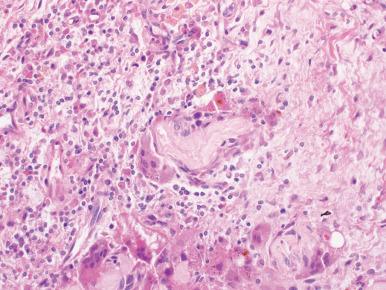
Osteomyelitis of the jaws of bacterial etiology usually represents an additional consequence and extension of dental or periodontal infection. Acute, subacute, and chronic forms exist. Some of the chronic forms are of the sclerosing (Garré) type. Hematogenous osteomyelitis is encountered more rarely. Symptoms such as pain, fever, and soft tissue swelling or redness in later stages are usually present. Smooth, regular, and atrophic loss of the covering mucosa is a late finding, and the exposed bone appears dull and devitalized. Radiographic features of osteomyelitis are subtle, irregular, ill-defined, and predominantly radiolucent lesions. A sequestrum is more often identified at the time of surgical exploration than during examination of x-ray films. Acute suppurative inflammation and resorptive scalloping of margins of nonvital bone within a large portion of maxilla or mandible are the main microscopic findings of acute and subacute osteomyelitis. Staphylococcus aureus is the organism most commonly cultured. Anaerobic bacteria have also been demonstrated to be important. Tuberculosis, mucormycosis, aspergillosis, and candidiasis have also been causally identified in osteomyelitis of the jaws.
Chronic forms of osteomyelitis generally appear histologically as benign fibro-osseous lesions with patchy chronic inflammation. The diagnosis often depends on the constellation of clinical, radiographic, and histologic findings. Another form of osteomyelitis of the jaw is that associated with the so-called SAPHO syndrome (synovitis, acne, pustulosis, hyperostosis, and osteitis). This variety is nonsuppurative and antibiotic therapy is usually not effective.
Osteonecrosis of the jaw bones can be seen following radiation therapy (osteoradionecrosis) or in patients being treated with bisphosphonates (osteochemonecrosis, bisphosphonate-related osteonecrosis). The mandible is affected more commonly than the maxilla and the lesions present as a painful mucosal ulcer with exposed underlying dead bone. Pathologic fractures may occur in the weakened bone. They are histologically similar with necrotic bone surrounded by acute and chronic inflammatory cells with superimposed colonization by oral microbial flora.
Simple bone cyst usually occurs in young patients as a sharply outlined, unilocular, radiolucent mass ( Fig. 5.2 ). It is usually located in the body or symphyseal area of the mandible and can assume a large size. In older patients it may also involve the maxilla. It is also known as traumatic , solitary , or hemorrhagic cyst , but there is a history of trauma in only one-half of the cases, and the content of the cyst is rarely hemorrhagic. Actually, little is observed within the cavity at surgery in the typical case; this feature is analogous to that seen in solitary (unicameral) bone cysts, of which simple bone cyst may be the gnathic counterpart. Morphologically, the cavity is entirely intraosseous and not lined by epithelium. Surgical samples from the periphery show instead a delicate fibrovascular lining of unremarkable appearance. A few osteoclast-like giant cells and hemosiderin-laden macrophages may be present. Surgical exploration with thorough curettage is the treatment of choice and is typically curative.
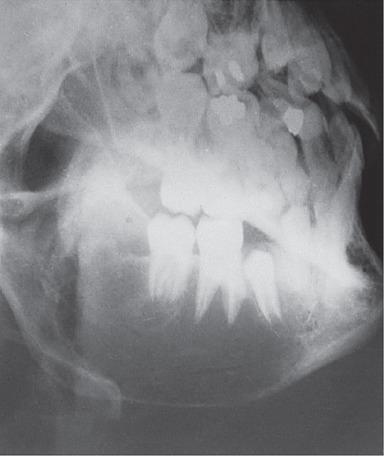
The differential diagnosis of simple bone cyst includes aneurysmal bone cyst (particularly when the latter is associated with a benign fibro-osseous lesion) and so-called latent bone cavity , a symptomless open cavity situated below and behind the inferior dental canal near the angle of the mandible and often containing salivary gland tissue.
Lesions of the jaws that feature large numbers of osteoclast-like, multinucleated giant cells include the following major entities: central giant cell lesion (granuloma), cherubism, giant cell tumor (osteoclastoma), fibro-osseous lesions, the bone lesion of hyperparathyroidism (brown tumor), hereditary hyperparathyroidism–jaw tumor syndrome, and aneurysmal bone cyst. Central giant cell granuloma is by far the most common. Its pathogenesis is unknown. Because a history of trauma is often ascertained, it has been suggested that it is the result of the organization of slow, minute, recurrent hemorrhages, hence the alternative name reparative giant cell granuloma coined by Jaffe in his classic paper on the subject. A benign neoplastic nature seems a more likely explanation given the fact that some do recur.
This condition affects children and young adults, predominantly females, and occurs almost twice as frequently in the mandible as in the maxilla, particularly in the anterior region. It produces a lytic lesion of the bone, which microscopically shows large numbers of multinucleated giant cells, hemosiderin, a cellular vascular stroma, and often new bone formation ( Figs. 5.3 and 5.4 ). The osteoclast-like giant cells have a patchy distribution, usually associated with areas of hemorrhage. Cases have been reported in association with central odontogenic fibroma.
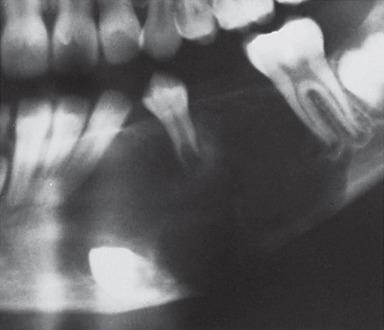
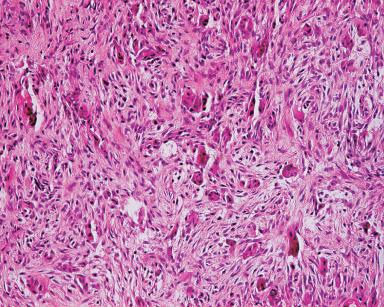
These lesions are treated by surgical removal or thorough curettage. Recurrence, which occurs in approximately one-fourth of the cases, is treated similarly but only after the diagnosis has been confirmed.
Cherubism (hereditary and intraosseous fibrous swellings of the jaws) is indistinguishable microscopically from the lesions of central giant cell granuloma. However, the bilateral presentation of mandibular and maxillary involvement in a young individual with an autosomal dominant mode of inheritance, the sometimes more delicate fibrovascular stroma with less consistent bone formation, and the differing behavior and response to treatment clearly justify a nosologic separation between the two. The gene responsible for cherubism has been mapped to chromosome 4p16.3, and identified as encoding c-Abl–binding protein SH3BP2.
Hyperparathyroidism, aneurysmal bone cyst, and other conditions containing areas resembling giant cell granuloma (especially at the periphery) may also constitute a basis for histologic misinterpretation. Fortunately, these are encountered much less commonly and are usually associated with additional clinical or laboratory information that aids delineation. Giant cell tumor only rarely, if ever, occurs in the jaw bones.
Several types of tumor and tumorlike conditions composed of benign fibro-osseous tissue exist. Their histologic features are very similar, whereas their clinical behavior can be very different. Their accurate diagnosis depends on an integration of the microscopic picture with the medical, family, and dental history, the radiographic and operative appearance, skeletal survey, and laboratory tests; furthermore, it may need to be revised on the basis of the course of the disease and response to treatment. The pathologist who relies on histology alone for the interpretation of these lesions is less likely to contribute to the successful management of these patients. Common benign fibro-osseous lesions of the jaw bones are listed in Box 5.1 .
Fibrous dysplasia
Monostotic
Polyostotic
Syndromic (McCune–Albright)
Ossifying fibroma
Conventional
Psammomatous (juvenile)
Trabecular (juvenile)
Cementoblastoma
Osseous dysplasia
Periapical
Focal
Florid
Fibrous dysplasia can be polyostotic or monostotic, the microscopic appearance of the two forms being essentially the same. The polyostotic form may be accompanied by pigmented skin lesions, endocrine dysfunction presenting with precocious puberty in females, and other anomalies (McCune–Albright syndrome) . Both monostotic fibrous dysplasia and Albright syndrome are associated with a somatic mutation of the GNAS1 gene. Fibrous dysplasia confined to jawbones is sometimes referred to as the craniofacial form of the disease. Approximately 10% of patients with monostotic fibrous dysplasia present with involvement of the craniofacial skeleton. In contrast, a vast majority of those with polyostotic disease have involvement of the craniofacial bones. Congenital or hereditary fibrous dysplasia in siblings has been reported and should not be confused with cherubism.
Clinically, painless and sometimes dramatic swellings of the maxilla or mandible are observed that are characteristically unilateral. Young individuals are usually affected, the mean age at time of diagnosis in most series being from 25 to 35 years. The lesions tend to become static as skeletal maturity is reached. The radiographic appearance varies from cystic or radiolucent to sclerotic or radiopaque, and the margins tend to be ill-defined.
The histologic appearance of fibrous dysplasia in its usual, most recognizable form is characterized by the presence of curvilinear trabeculae of woven or immature bone within a proliferating benign fibroblastic stroma ( Fig. 5.5 ). Osteoblastic rimming of these trabeculae is usually absent, but its presence focally (particularly at the periphery of the lesion) does not rule out a diagnosis of fibrous dysplasia. Two main morphologic variations on this theme are represented by lesions in which there is deposition of either lamellar bone with prominent osteoblastic rimming or rounded psammoma-like masses resembling cement. These two variations can be seen in lesions of the craniofacial skeleton but are typically not seen in lesions involving the long bones.
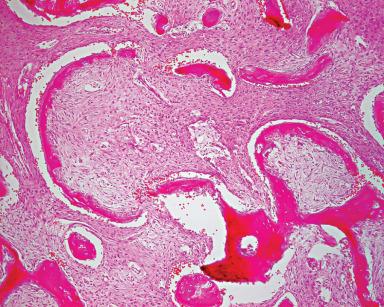
Ossifying fibroma (cementifying fibroma, cemento-ossifying fibroma) is a benign neoplasm occurring in the tooth-bearing regions of the jaw bones. They occur most often in the mandible of adults, and there is a female predilection. They present as an expansile lytic or mixed lytic-sclerotic bone lesion or are discovered incidentally in imaging studies and are well demarcated in contrast to fibrous dysplasia ( Figs. 5.6 and 5.7 ). Histologically, they consist of a collagenous spindled stroma associated with varying amounts and types of mineralized tissues ( Fig. 5.8 ). These can include globules of dense bone, trabeculae of woven or lamellar bone, and cementum-like calcifications. In contrast to fibrous dysplasia, there is less histologic uniformity in a given lesion; however, significant histologic overlap exists requiring correlation with imaging and clinical findings.
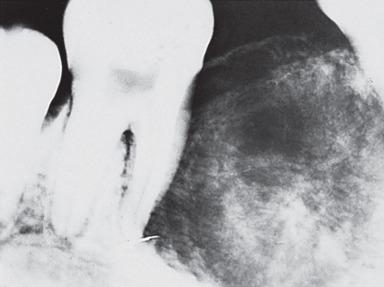
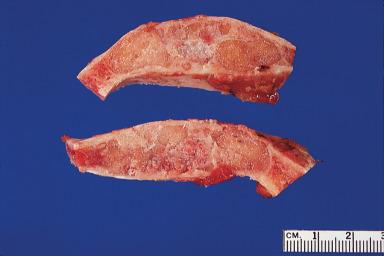
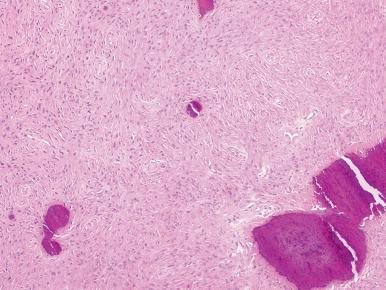
Two variants of ossifying fibroma have been described, and these typically present in children with rapidly growing bone tumors of the craniofacial skeleton. As such, they have been referred to as “aggressive” and “juvenile” ossifying fibroma. They are the psammomatoid and trabecular variants, but they may be unrelated to conventional ossifying fibroma. The psammomatoid ossifying fibromas usually occur in older children and involve the periorbital bones and paranasal sinuses preferentially but do occur in the mandible. Radiologically, they are well circumscribed and typically lytic. Histologically, there is a cellular, benign, spindled stroma associated with numerous, round, basophilic ossicles that resemble psammoma bodies ( Fig. 5.9 ). Simple excision is the treatment of choice, but lesions can recur. Trabecular ossifying fibromas occur in younger children and present with a rapidly growing tumor involving the maxilla most often followed by the mandible. Microscopically, they consist of a cellular spindled stroma with bundles of osteoid that matures to woven bone and lamellar bone with a zonal-type appearance. Stromal hemorrhage and aggregates of osteoclast are scattered throughout. Aneurysmal bone cyst changes and cystic degeneration are not uncommon. They are treated by simple excision but frequently recur.
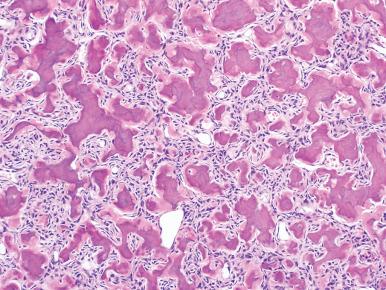
It seems likely that all of these lesions might have a periodontal ligament origin. Overall, these lesions show a marked predilection for females and for the molar–premolar region of the mandible. Some authors have stressed the importance of separating fibrous dysplasia from the ossifying fibroma group of lesions because the latter are better-demarcated lesions that are more amenable to surgical enucleation or to curettage. These practical considerations justify a segregation for therapeutic and prognostic purposes, which are backed by immunohistochemical and molecular genetic data. Thus, fibrous dysplasia (whether gnathic or extragnathic) has been found to exhibit a much stronger immunoreactivity for osteocalcin and to consistently harbor mutations of the GNAS1 gene, whereas ossifying fibroma does not.
There are additional fibrous and ossifying, calcifying, or cementifying conditions of the jaws that may be linked to fibro-osseous lesions because of their histologic resemblance, although some of them may be of odontogenic nature.
Osseous dysplasia (periapical, focal, and florid) is a relatively common disorder, being detectable radiographically in 0.3% of the adult population. It is usually multiple and asymptomatic, is limited to small regions surrounding apices of teeth, and ordinarily does not require treatment. It is thought to be of periodontal ligament origin and non-neoplastic in nature. An autosomal dominant form of this disorder has been described.
Mandibular incisor regions of black female adults usually are involved, but there are some differences among the three variants. Occasionally, a single tooth is affected, and this may become a surgical specimen. Periapical osseous dysplasia occurs in middle-aged black women and involves the apex of a single tooth, usually a mandibular incisor. Focal osseous dysplasia is similar to the periapical type but involves multiple teeth in the posterior mandible. Florid osseous dysplasia is similar to the focal type except that multiple jaw quadrants are involved and the lesions are more often symptomatic. Microscopically all three are identical; the most typical feature is the presence of curvilinear trabeculae (“ginger root” pattern) or irregularly shaped cementum-like masses set within a vascular stroma ( Fig. 5.10 ). The main differential diagnosis is with ossifying fibroma, which is well-circumscribed and shows thin isolated trabeculae with prominent osteoblastic rimming; however, significant histologic overlap exists.
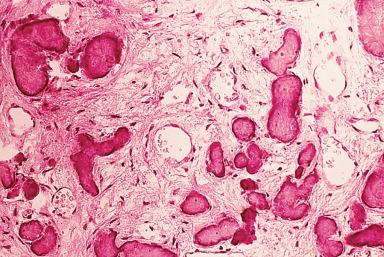
Benign osteoblastoma can occur in the jaw, sometimes in intimate relationship to a dental root surface. When the latter is the case, the alternative designations of (benign) cementoblastoma and true cementoma are sometimes used ( Figs. 5.11 and 5.12 ).
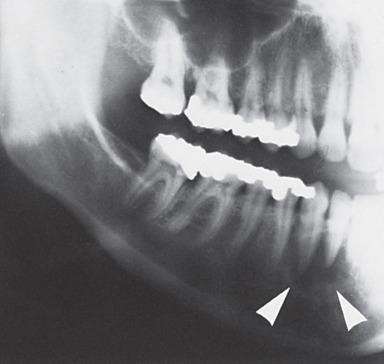
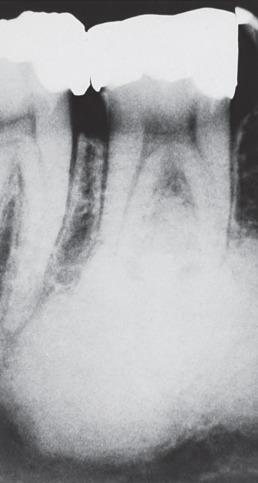
The clinical course is usually innocuous, the lesion often stabilizing as a heavily calcified nodule. However, the fact that some lesions are locally aggressive indicates that surgical excision is the treatment of choice.
Microscopically, this lesion features irregular osteoid and bone formation (or cementum) within proliferative fibrovascular connective tissues. Plump benign-appearing osteoblasts are seen rimming the newly formed trabeculae ( Fig. 5.13 ). Osteoblastomas exhibiting a prominent epithelioid configuration of the osteoblasts are referred to as aggressive and are regarded by some as low-grade (nonmetastasizing) malignancies given the increased rate of recurrence.
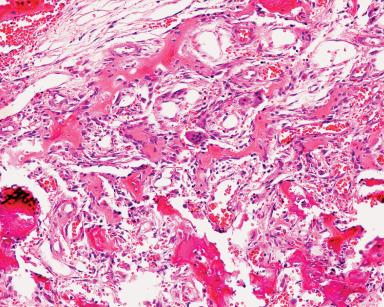
Other lesions of the jaw featuring bone or cementum formation within proliferative fibrous connective tissue include solitary large or “gigantiform” cementomas , and osteomas (especially those observed in patients with Gardner syndrome). Inflammatory lesions of the jaws during their sclerotic or healing phases and Paget disease also enter in the differential diagnosis.
Epithelium-lined cysts of the maxilla or mandible are among the more commonly encountered jaw diseases from both the clinician's and the pathologist's perspective. Most cannot be identified specifically on the basis of their histologic appearance alone. Therefore, integration of radiographic, surgical, and microscopic findings is necessary to reach a specific diagnosis.
Two major categories of epithelial cyst exist: odontogenic and fissural (nonodontogenic). Odontogenic cysts arise from the odontogenic epithelium and are located within the jaw (or, rarely, in the adjacent soft tissues). Fissural (nonodontogenic) cysts are thought to arise from epithelial inclusions within soft or bony portions of the region that lack the embryologic and tooth-forming heritage of odontogenic epithelium. They occur along embryologic fissure lines and, therefore, usually occur outside of the jaw bones. Several subtypes of these two major categories are listed in Box 5.2 .
Dentigerous cyst
Eruption cyst
Gingival cyst
Lateral periodontal and botryoid odontogenic cysts
Calcifying cystic odontogenic tumor
Radicular or periapical cyst (including residual cyst)
Keratocystic odontogenic tumor
Solitary or primordial
Multiple (nevoid basal cell carcinoma syndrome)
Orthokeratinized odontogenic cyst
Glandular odontogenic cyst
Nasolabial (Klestadt or nasoalveolar) cyst
Nasopalatine duct (median anterior palatal) cyst
Palatal cyst
Dentigerous cysts surround or are associated with unerupted teeth and usually are found in young adults. They are found in almost 1% of individuals having complete dental roentgenograms and are often discovered incidentally. They arise from alterations of reduced enamel epithelium after development of enamel and are associated with the tooth crown, at least initially. They develop from fluid accumulating between the crown of the tooth and the reduced enamel epithelium which is just beneath the dental follicle connective tissue. Swelling and, rarely, pain are symptoms, but they occur late or with infection and inflammation.
Microscopically, the uncomplicated dentigerous cyst has a thin fibrous wall (dental follicle connective tissue) lined by stratified squamous epithelium. Secondary changes in the form of chronic inflammation, ulceration, reactive hyperplasia, metaplasia (squamous and mucinous), calcification, and clusters of histiocytes containing hemosiderin and lipofuscin are common. Dysplasia and carcinoma can also develop in them, but this is exceedingly uncommon. Although uncommon, they are more likely to give rise to cystic ameloblastomas.
Surgical excision is the treatment of choice for dentigerous cysts. Recurrence is very unusual. When it occurs, incomplete removal or the alternative possibilities of keratocystic odontogenic tumor and early or cystic examples of ameloblastomas should be considered.
Eruption cyst is a subtype of dentigerous cyst that may be unilateral or bilateral, single or multiple. It presents as a gingival swelling above erupting primary or, rarely, permanent teeth. Surgical exposure of the affected tooth reveals a subacutely inflamed and hemorrhagic cyst wall lined by usually thin and nonkeratinizing stratified squamous epithelium.
Gingival cysts of newborn infants (Bohn nodules) present as minute cystic or nodular formations; they are seen in most neonates and gradually disappear, usually in a matter of weeks. Microscopically, they are lined by stratified squamous epithelium that are sometimes parakeratotic. Occasionally, gingival cysts are seen in adults.
Lateral periodontal and botryoid odontogenic cysts probably represent cystic remnants of the dental lamina. They are remarkable by virtue of their anatomic location, usually apposing gingival or root surfaces of teeth in adults. Mandibular premolar regions are the most frequent sites of occurrence. They are usually unilocular but can present as a multilocular cyst. The latter have been termed botryoid odontogenic cysts. Microscopically, they are lined by an extremely thin stratified squamous epithelium, one or two layers thick. Small nodular collections of glycogen-containing epithelial clusters can be seen, especially in the botryoid odontogenic cysts.
Calcifying cystic odontogenic tumor (keratinizing and calcifying odontogenic cyst, Gorlin cyst) is characterized by a cyst lining of ameloblastic epithelium with prominent basal palisading and large masses of keratinized “ghost” cells ( Fig. 5.14 ). The ghost cells undergo varying degrees of dystrophic calcification. Some of the cells may exhibit clear cell changes, and others may contain melanin pigment. The epithelium can induce dentinoid matrix production in the underlying stroma. Some examples show a remarkable similarity with ameloblastoma and craniopharyngioma, from which they are distinguished by the presence of the characteristic ghost cells and dentinoid, respectively. It has been proposed that lesions in which this proliferation is solid represent the neoplastic counterpart of the calcifying cystic odontogenic tumor, and the term dentinogenic ghost cell tumor has been proposed for them. Indeed, it may well be that all of the lesions in this category are tumors exhibiting varying (and sometimes very extensive) degrees of cystic change, a possibility supported by the common presence of molecular alterations in the form of β-catenin gene mutations. Aberrant nuclear accumulation of β-catenin is a characteristic finding, attributable to the presence of somatic mutations in the encoding gene CTNNB1 . Enucleation is the treatment of choice which is associated with a very low recurrence risk.
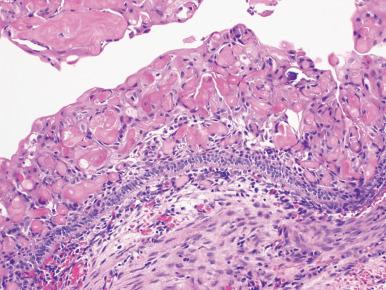
Radicular or periapical cysts are a sequela of dental inflammatory disease and represent the most frequently encountered cyst of the jaws. They occur in all age groups but are more commonly diagnosed during the third and fourth decades. Those observed within the maxilla or the mandible after tooth extraction are called residual cysts . Radiographically, periapical cysts present as a well-circumscribed radiolucency at the apex of affected nonvital teeth ( Figs. 5.15 and 5.16 ). Microscopically, they are lined by stratified squamous epithelium, the thickness of which varies according to the degree of inflammation present. Ulceration is common, and epithelium may be difficult to identify. When present, it may exhibit metaplasia, calcification, and hyaline (Rushton) bodies ( Fig. 5.17 ). The inflammatory infiltrate in the wall may be acute, chronic, or mixed. Aggregates of cholesterol crystals, foamy macrophages, multinucleated giant cells, and plasma cells are common. The cyst usually is easily curetted from the surrounding bone, and recurrence is rare. At surgery, the cyst may be found attached to the apex of the extracted tooth.
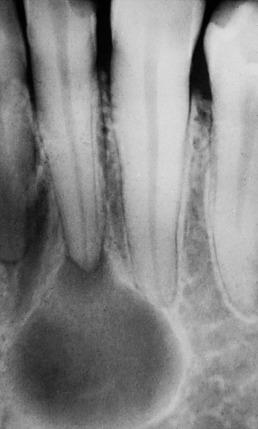
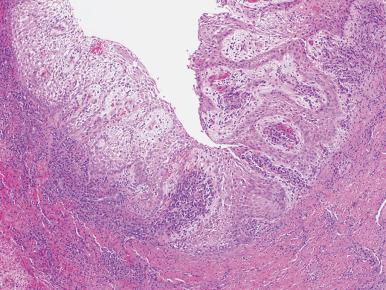
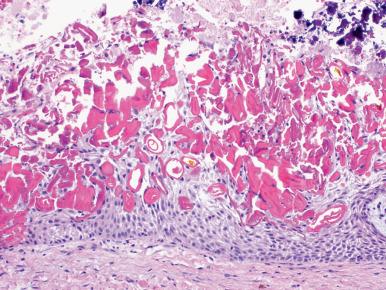
Keratocystic odontogenic tumor (odontogenic keratocyst) constitutes approximately 10% of cysts of the jaw and ordinarily can be diagnosed on the basis of their histologic features. Although they can occur in any portion of the jaw, most are found in the posterior mandibular regions. They have been divided into solitary or primordial (90%) and multiple (10%). The latter are a component of the nevoid basal cell carcinoma syndrome (Gorlin syndrome) , together with cutaneous nevoid basal cell carcinomas, palmar/plantar pits, calcification of the falx cerebri, cutaneous epidermoid cysts, and numerous types of skeletal abnormalities. This syndrome is transmitted by an autosomal dominant gene having high penetrance and variable expressivity. Germline mutation of the human homologue of Drosophila patched (PTCH1) , a tumor suppressor gene located at 9q22.3–q31, is the underlying molecular defect in this syndrome.
Keratocysts occur most frequently in the third molar region of the mandible ( Figs. 5.18 and 5.19 ). The mean age of the patients is 40 years. The cysts are more frequently multilocular and more commonly associated with swelling and pain than are dentigerous cysts.
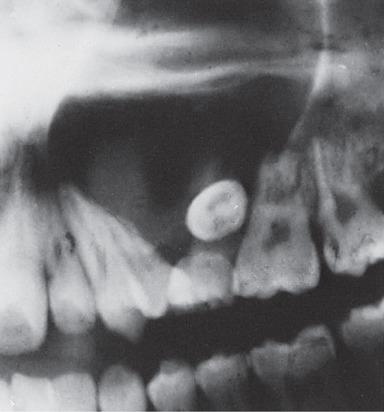
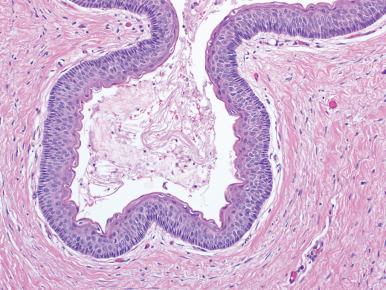
Grossly, the cyst cavity contains a cheesy material consisting of keratinous debris that, when flushed away, reveals a white, subtly wrinkled surface. Microscopically, the epithelial lining is of uniform thickness and approximately 5–7 cells thick. It is a parakeratinized squamous epithelium with prominent palisading of the basal cell layer and a wavy, corrugated, or mildly verrucous surface of parakeratin. Secondary inflammation can obscure these characteristic histologic findings. Small “daughter” cysts and basaloid odontogenic rests can be seen in the connective tissue stroma. These should be separated from the cystic lesions exhibiting an orthokeratinized lining, on the basis of less aggressiveness associated with the latter (orthokeratinized odontogenic cysts) . The majority of keratocystic odontogenic tumors have been found to harbor chromosomal abnormalities, supporting the supposition that they are of neoplastic nature, resulting in the renaming of the entity from “odontogenic keratocyst.” The Sonic Hedgehog (SHH) signaling pathway plays a critical role in tooth development. PTCH1 combines with Smoothened (SMO) to form a receptor complex for the SHH ligand. Inactivating mutation and allelic loss of PTCH1 resulting in aberrant activation of the SHH signaling pathway represent the key genetic event of both sporadic and nevoid basal cell carcinoma syndrome-related keratocysts.
Keratocystic odontogenic tumors have a high rate of recurrence, which has ranged from 23% to 60% in the various series. This has been variously attributed to technical difficulties with curettement due to the multilocularity of the cysts and the friability of the material, presence of epithelial remnants in the wall, and budding of the epithelial lining within the cyst wall.
Glandular odontogenic cysts (sialo-odontogenic cysts) are most often seen in adults and have a predilection for the anterior jaw, especially the mandible. They can be unilocular or multilocular and have a recurrence risk similar to keratocystic odontogenic tumors. Microscopically, they are lined by stratified squamous epithelium with eosinophilic cuboidal surface cells in areas ( Fig. 5.20 ). They contain mucous cells and duct-like structures as well and can therefore be confused with mucoepidermoid carcinoma. Small nodular collections of glycogen-containing epithelial clusters can be seen, similar to those in lateral periodontal/botryoid odontogenic cysts.
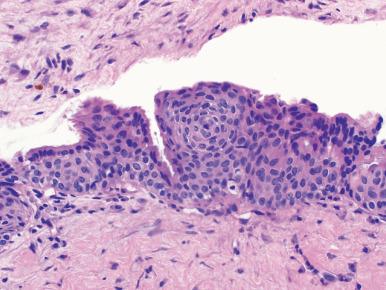
Nasolabial (Klestadt or nasoalveolar) cyst predominantly occurs in females and is commonly bilateral. Originally thought to arise from epithelial rests at the embryologic junction of the globular, lateral nasal, and maxillary processes, development from the caudal end of the nasolacrimal rod or duct is currently favored. The nasoalveolar cyst occurs near the base of the nostril, outside the alveolar process of the maxilla. It eventually obliterates the nasolabial fold and gently presses its way toward the nasal mucosa. Microscopically, the lining may be of stratified squamous or respiratory type.
Nasopalatine duct (incisive canal) cyst may be intraosseous or be located within the soft tissues of the palatine papilla. It represents cyst formation of embryologic remnants of the incisive canal joining the oral and nasal cavities and is the most common type of fissural or nonodontogenic cyst. Microscopically, it is lined by respiratory or stratified squamous epithelium (sometimes pigmented) or a combination of both. Frequently, the nasopalatine neurovascular bundle is present in the stroma adjacent to the cyst epithelium, as well as minor salivary gland, adipose, and cartilage tissues.
Palatal cysts in newborn infants (Epstein pearls) are located at the junction of the hard and soft palate and are microscopically similar to gingival cysts.
Odontogenic tumors are neoplasms of the jaws which differentiate toward tooth structures. Despite their rarity, there is a great variety of types, with numerous transitional forms. This has resulted in many classification attempts, beginning with the histologic scheme proposed by Broca in 1867. Thoma and Goldman in 1946 classified them histogenetically into epithelial, mesodermal, and mixed, whereas Pindborg and Clausen in 1958 stressed the phenomenon of induction (as a mechanism of differentiation) over histogenesis. Subsequent authors have slightly rearranged these types and added a few, most of which are included in the current classification scheme from the World Health Organization (WHO).
The following grouping ( Box 5.3 ) presents odontogenic tumors in a simplified fashion for the general surgical pathologist. It emphasizes their clinical behavior, which is benign for most types.
Become a Clinical Tree membership for Full access and enjoy Unlimited articles
If you are a member. Log in here